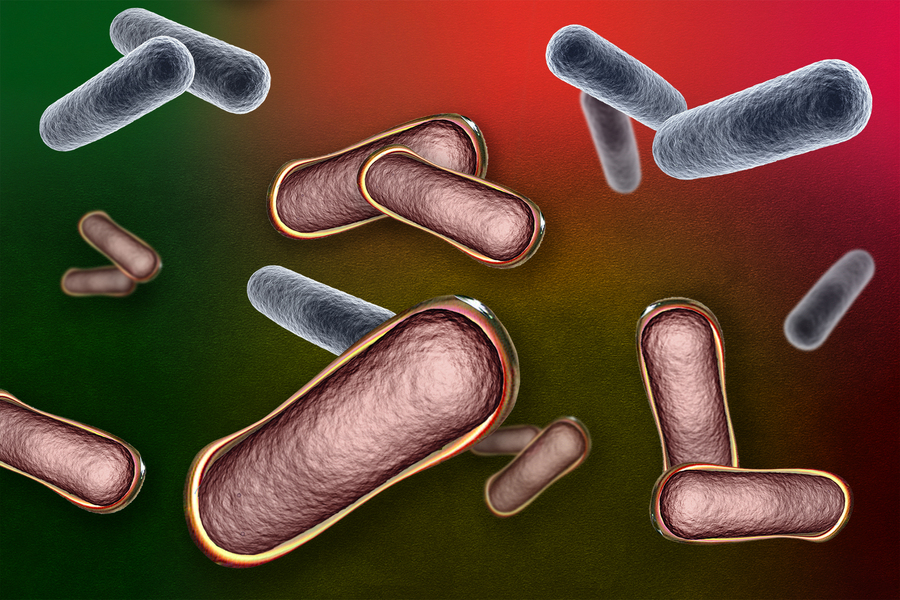A Step Toward “Living Biotherapeutics”
Chemical engineers created a coating for microbes that could make it easier to deploy the organisms to treat gastrointestinal disease.
 The human gut is home to thousands of species of bacteria, and some of those bacteria have the potential to treat a variety of gastrointestinal diseases. Some species may help to combat colon cancer, while others could help treat or prevent infections such as C. difficile.
The human gut is home to thousands of species of bacteria, and some of those bacteria have the potential to treat a variety of gastrointestinal diseases. Some species may help to combat colon cancer, while others could help treat or prevent infections such as C. difficile.
One of the obstacles to developing these “living biotherapeutics” is that many of the species that could be beneficial are harmed by oxygen, making it difficult to manufacture, store, and deliver them. MIT chemical engineers have now shown that they can protect those bacteria with a coating that helps them to survive the manufacturing process.
In a study appearing today in the Journal of the American Chemical Society, the researchers showed they could use the coating on a strain of E. coli as well as another species that may aid in digestion of plant starches. The coating could be applied to many other species as well, they say.
“We believe this coating could be used to protect pretty much any microbe of interest,” says Ariel Furst, the Raymond and Helen St. Laurent Career Development Professor of Chemical Engineering and the senior author of the new study. “We think there are microbes out there that can help with a variety of diseases, and that we can protect them for manufacture and production.”
MIT postdoc Gang Fan is the lead author of the study. Pris Wasuwanich, an MIT undergraduate, and Mariela Rodriguez-Otero, a former MIT Materials Research Laboratory Summer Scholar, are also authors of the paper.
Protective coating
Most of the microbes that live in the human gut are anaerobic, and they have varying degrees of sensitivity to oxygen. Some can tolerate a little bit of oxygen, while for others, oxygen is deadly.
This makes it difficult to test their potential as treatments for human disease, because bacteria need to be freeze-dried and formulated as capsules in order to be used therapeutically. In this study, Furst and her colleagues decided to try protecting anaerobic bacteria by coating them with a material made from metal ions and organic compounds called polyphenols.
When polyphenols and metal ions are put into a solution, they form a two-dimensional, grid-like sheet. For this study, the researchers used iron, which is safe for human consumption, and three polyphenols that are all classified as GRAS (generally regarded as safe) by the Food and Drug Administration: gallic acid, tannic acid, and epigallocatechin, all of which are found in tea and other plant products.
If bacteria are also added to the solution, the material self-assembles into a coating on individual bacterial cells. This coating protects bacteria during the freeze-drying and manufacturing process. The researchers showed that the coated cells were healthy and able to perform normal cellular activities, although their growth was temporarily inhibited.
When exposed to an acidic environment, such as that of the stomach, the coating breaks down and releases the bacteria.
Deploying bacteria
One of the strains that the researchers used to test the coating is Bacteroides thetaiotaomicron. This species, which has enzymes specialized to digest carbohydrates, appears to be more abundant in the gut microbiome of healthy people. However, it has been difficult to study how these bacteria might promote health if given as biotherapeutics, because they are very sensitive to oxygen.
Bacteria with this type of protective coating could also be useful for agricultural applications such as helping to make crops more stress-tolerant. Another possible application for the coating is to use it to protect microbes that are used as vaccines. The BCG vaccine, which consists of the bovine version of the microbe that causes tuberculosis, is difficult to produce and must be stored at low temperatures. Coating it with a protective layer could eliminate the need for cold storage and make distribution easier, Furst says.
“If we can remove the need for cold storage and transport, we think it would make a lot of therapeutics more widely available,” she says.
The research was funded by the MIT-Deshpande Center, the Undergraduate Research Opportunities Program at MIT, and the MIT Materials Research Laboratory MRSEC Program of the National Science Foundation.
Publication: Gang Fan, et al., Protection of Anaerobic Microbes from Processing Stressors Using Metal–Phenolic Networks, ACS Publications (2023) DOI : 10.1021/jacs.1c09018
Original Story Source: Massachusetts Institute of Technology

 Alerts Sign-up
Alerts Sign-up